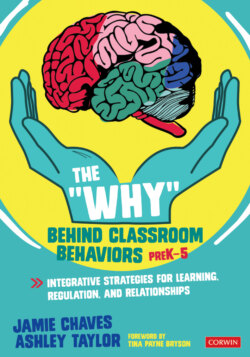Читать книгу The "Why" Behind Classroom Behaviors, PreK-5 - Jamie Chaves - Страница 17
На сайте Литреса книга снята с продажи.
Strategy 3: Identify Vulnerabilities and Reframe Triggers
ОглавлениеWe often hear teachers say they want to help particular students who are struggling, but they don’t know how or where to start. We hope this book will serve as a resource for you, as teachers, to empower, equip, and engage students. As a result, we will see students thriving who once were failing; students engaging who once were withdrawing; students supported who once were penalized; and teachers who feel successful, empowered, and ready to take on new challenges.
As teachers, you likely spend so much time thinking and worrying about your students. Wondering what triggered certain behaviors, and how to help them navigate certain situations better next time. You likely don’t have too much time to think about yourself, what triggers you, and how to better support your vulnerabilities. We hope to be able to provide you with the opportunity to care for yourself and reflect with the activities in this book.
Trigger: an event or behavior that occurs causing teachers and/or students to enter a state of dysregulation.
Vulnerability: an underlying area of functioning that is not yet fully developed or integrated.
It is therefore important to spend a few minutes thinking about your triggers and vulnerabilities as well. You may notice that there are certain students, parents, or particular stressful situations that trigger you to become more dysregulated. Identifying such triggers can allow you to better explore “why” you may be triggered and what vulnerabilities underlie your triggers. Vulnerabilities may include a sensory sensitivity, a learning difference or disability, a traumatic memory, or a skill that has not yet been fully mastered. We will explore individual differences as well as additional potential underlying vulnerabilities in Chapter 6. In this way, your triggers can be reframed as a learning experience and your vulnerabilities as an opportunity for growth. When you feel yourself becoming triggered, it is important to be more conscious about how you can regulate yourself so that you can then co-regulate with a student to prevent both of you from entering a heightened state of dysregulation together. Keep these triggers and vulnerabilities in mind as we move through the principles and strategies in this book.
We all fluctuate between different states of arousal and regulation throughout the day. In the fast-paced classroom environment with over 20 students, it can be difficult to identify what the trigger was, let alone what vulnerability may be underlying the trigger that is causing the particular student to become upset. This can also happen to us as adults, since it is sometimes hard to know why we are triggered or overwhelmed. By building insight into your own states, warning signs, and vulnerabilities, you can better maintain your own state of regulation and ultimately model this for your students. Likewise, it is important to remember that a student is not doing certain things to you or the behaviors aren’t directed at you. At times, a student’s challenging behavior may feel manipulative. It might feel as though they are doing something intentionally to push your buttons or get on your nerves. Most of the time, however, challenging behaviors from students are a cry for help, and an attempt on their part to connect with you. However, they likely do not know how to connect with you or ask for help in an adaptive way. When you find yourself feeling as though a particular student is doing something on purpose to intentionally make you mad, remember, it is not your fault—try not to take it personally!
While you’ve likely spent time thinking about your students’ triggers, we invite you look even deeper. What might underlie the triggers? How can we identify what vulnerabilities may be hiding underneath the behavior, and even underneath the trigger to the behavior? Students who frequently experience triggering events at school may need extra support through co-regulation and brain integration. Asking “why” a student might be triggered is the starting point to better understand the vulnerability underneath his behavior. There are many reasons and potential vulnerabilities why a student may be triggered. From individual differences, sensory preferences, learning styles, temperaments, learning disabilities and SPDs, there are many reasons why students may enter a state of dysregulation. Let’s take a moment now to think about a student who may be particularly challenging and hypothesize why this might be.
